Introduction
I'm trying to analyze an op amp circuit from first principles (i.e. without using the two rules of ideal op amp analysis -- virtual short circuit and infinite input impedance). The circuit itself is complicated but, for the purposes of this question, one could simply consider a non-inverting amplifier topology:

simulate this circuit – Schematic created using CircuitLab
Ordinarily I would take the op amp gain to be \$A_v(V_+ - V_-)\$, and performing the analysis, would get the following relationship between \$V_{in}\$ and \$V_{out}\$:
\$V_{out} = V_{in} \frac{A_d}{1 + A_d \frac{R_2}{R_1 + R_2}}\$.
With the usual simplifying assumption of infinite op amp gain, we have
\$\lim_{A_d \to \infty} V_{in} \frac{A_d}{1 + A_d \frac{R_2}{R_1 + R_2}} = V_{in} \left( 1 + \frac{R_1}{R_2} \right)\$,
as expected. However, this doesn't take into effect the CMRR of the op amp.
Purpose of the question
I feel it is important to justify my reasoning for this, since I want to know whether the models and simplifying assumptions are valid in a specific context.
I am trying to systematically analyze the error sources in a precision op amp circuit (the actual circuit will be built with a chopper op amp), and the final model will have additional error sources such as voltage offset, bias and offset currents, noise, etc. The precision required is in the order of 10-100 ppm, so I need to consider every possible error source. The final goal is to plug in the parameters from a given op amp's datasheet (including CMRR, which is the topic of this question) and get numerical values for the errors, to build an error budget.
Therefore, any simplifying assumptions (e.g. that of the final section) may be considered valid if they lead to expression for the errors that, if not exact, are very close to the actual errors. For instance, if a full expression claims a 1.0001 ppm error, but a simplified expression claims 1 ppm, I'm OK with that.
Modified model taking CMRR into account
My first question is whether a valid model that considers the op amp ideal, other than a finite CMRR, is to define \$V_d = V_+ - V_-\$ and \$V_{cm} = (V_+ + V_-)/2\$, and modify the op amp gain expression to be \$V_{out} = A_d V_d + A_{cm} V_{cm}\$. Under this model, the new relationship between \$V_{out}\$ and \$V_{in}\$ is:
\$V_{out} = V_{in} \frac{A_d + A_{cm}/2}{1 + \frac{R_2}{R_1 + R_2} (A_d - A_{cm}/2)}\$
As a check on the plausibility of the result, it is easily seen that setting \$A_{cm} = 0\$ gets us back to the regular, non-CMRR equation above.
Parameters for a given op amp model (e.g. 741)
The second question is how to extract these parameters from a given op amp's datasheet. Consider a 741 (evidently, that's not what I'm going to be using in my precision design; it's just meant to be a ubiquitous example.)
Section 6.5 claims a minimum large signal voltage gain (which is \$A_d\$, in my understanding) of 25 V/mV over the full temperature range. In the same section, the minimum CMRR over the full temperature range is claimed to be 80 dB = 10 V/mV.
Therefore, I understand that \$A_{cm} = A_d/\mathrm{CMRR} = 25/10 = 2.5\ \mathrm{V/V}\$. So, for the case of the 741, and assuming that we are interested in guaranteed minimum values over the full temperature range, I would take the op amp gain equation as \$V_{out} = 25000 V_d + 2.5 V_{cm}\$.
The actual question is: is this correct?
A simplifying assumption
The analysis does get a bit unwieldy with the expanded expression for the op amp gain \$V_{out} = A_d V_d + A_{cm} V_{cm}\$, when compared to the ideal case of \$V_{out} = A_d V_d\$.
Seeking to simplify the analysis a bit, it is seen by inspection of the circuit that \$V_{cm} \approx V_{in}\$, using the virtual short circuit rule of simplified op amp analysis. This is off by a few parts per million, but since in a real op amp we have \$A_{cm} \ll A_d\$, this should mean that any errors in the output voltage due to taking \$V_{cm} = V_{in}\$ are probably in the parts per billion range and can be effectively disregarded. Under this assumption, the algebra is considerably simplified, and we obtain the following expression:
\$V_{out} = V_{in} \frac{A_d + A_{cm}}{1 + A_d \frac{R_2}{R_1 + R_2}}\$
The final question is whether the simplification is indeed reasonable to apply. I believe it is by the argument above, but perhaps there is something that I'm missing.
A numerical check of the simplifying assumption
Let's go for a numerical check, assuming for the sake of the example \$R_1 = R_2\$, and therefore an ideal gain of 2 for the circuit.
First, admitting infinite CMRR but finite open loop gain of 25 mV/V, we have:
\$V_{out} = V_{in} \frac{25000}{1 + 25000 \times 1/2} \approx 1.99984 V_{in}\$.
Next, admitting a finite CMRR of 0.1 mV/V (therefore \$A_{cm} = 2.5\$, as before), but without the simplifying assumption of \$V_{cm} = V_{in}\$, we have:
\$V_{out} = V_{in} \frac{25000 + 2.5/2}{1 + (1/2) \times (250000 - 2.5/2)} \approx 2.0000399988 V_{in}\$.
Finally, adding the assumption of \$V_{cm} = V_{in}\$, we have:
\$V_{out} = V_{in} \frac{25000 + 2.5}{1 + 25000 \times (1/2)} \approx 2.0000399968 V_{in}\$.
Note that the error of the full expression with finite CMRR, compared to the infinite CMRR case, is:
\$(2.0000399988 - 1.99984)/2.0000399988 = 99.997\ \textrm{ppm} \approx 100\ \textrm{ppm}\$.
On the other hand, the error of the simplified expression with finite CMRR, compared to the infinite CMRR case, is:
\$(2.0000399968 - 1.99984)/2.0000399968 = 99.9964\ \textrm{ppm} \approx 100\ \textrm{ppm}\$.
The error between the full and simplified expressions is:
\$(2.0000399988 - 2.0000399968)/2.0000399968 \approx 1\ \textrm{ppb}\$.
For my purposes, I consider that a 1 ppb error compared to a 100 ppm error is negligible, so from this numerical check, it appears that the simplifying assumption is valid.